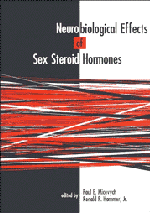Book contents
- Frontmatter
- Contents
- List of contributors
- Dedication
- Preface
- Acknowledgments
- Part I Sex steroid–responsive circuits regulating male and female reproductive behaviors
- Part II Sex steroid interactions with specific neurochemical circuits
- Part III Cellular and molecular mechanisms regulated by sex steroids
- 12 Neurosteroids and neuroactive steroids
- 13 Estrogen synthesis and secretion by the songbird brain
- 14 Neurobiological regulation of hormonal response by progestin and estrogen receptors
- 15 Molecular actions of steroid hormones and their possible relations to reproductive behaviors
- 16 Effects of sex steroids on the central nervous system detected by the study of Fos protein expression
- 17 Developmental interactions of estrogens with neurotrophins and their receptors
- 18 Sex steroid influences on cell–cell interactions in the magnocellular hypothalamoneurohypophyseal system
- Index
14 - Neurobiological regulation of hormonal response by progestin and estrogen receptors
Published online by Cambridge University Press: 15 October 2009
- Frontmatter
- Contents
- List of contributors
- Dedication
- Preface
- Acknowledgments
- Part I Sex steroid–responsive circuits regulating male and female reproductive behaviors
- Part II Sex steroid interactions with specific neurochemical circuits
- Part III Cellular and molecular mechanisms regulated by sex steroids
- 12 Neurosteroids and neuroactive steroids
- 13 Estrogen synthesis and secretion by the songbird brain
- 14 Neurobiological regulation of hormonal response by progestin and estrogen receptors
- 15 Molecular actions of steroid hormones and their possible relations to reproductive behaviors
- 16 Effects of sex steroids on the central nervous system detected by the study of Fos protein expression
- 17 Developmental interactions of estrogens with neurotrophins and their receptors
- 18 Sex steroid influences on cell–cell interactions in the magnocellular hypothalamoneurohypophyseal system
- Index
Summary
Introduction
Ovarian hormones have many cellular actions in the central nervous system that result in changes of behaviors and reproductive physiology (Blaustein and Olster 1989). One approach to unraveling the cellular processes by which ovarian hormones act on the brain has been the study of hormonal regulation of female sexual behavior. While the induction of such behavior usually requires stimulation by ovarian hormones, the specific hormonal conditions required for the stimulation and inhibition of sexual behavior vary in accord with the antecedent hormonal conditions in each species. These hormonal conditions include patterns as different as the sequential presence of estradiol and progesterone in rats and guinea pigs (Dempsey et al. 1936; Boling and Blandau 1939), the sequential presence of progesterone and estradiol in sheep (Robinson 1954), the presence of estradiol alone in prairie voles (Dluzen and Carter 1979), and the presence of testosterone metabolized neuronally to estradiol in musk shrews (Rissman 1991). We have studied the hormonal regulation of sexual behavior in rats and guinea pigs by the sequential presence of estradiol and progesterone. In ovariectomized guinea pigs injected with estradiol and progesterone, as during the estrous cycle, the period of sexual receptivity lasts for approximately 8 hours. While the specific cellular endpoints may vary in each of these species, the fundamental cellular processes by which hormones act are likely to be similar in all species.
- Type
- Chapter
- Information
- Neurobiological Effects of Sex Steroid Hormones , pp. 324 - 349Publisher: Cambridge University PressPrint publication year: 1995
- 3
- Cited by



